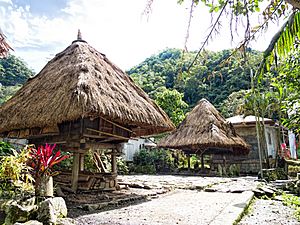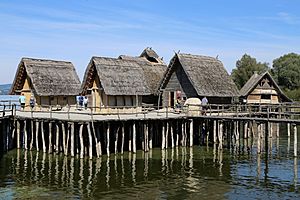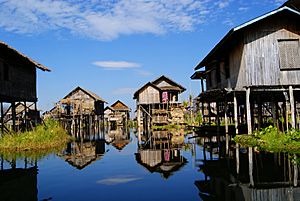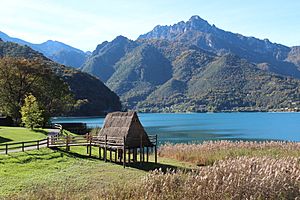Stilt house facts for kids
Stilt houses are special homes built on tall poles, called stilts or piles. These houses are raised above the ground or over water. People build them mainly to stay safe from flooding. They also help keep out small pests like vermin. The space under the house is often used for storage or for working.
Contents
Stilt Houses in Cold Places

In very cold places like the Arctic, the ground often has permafrost. Permafrost is soil that stays frozen all year round. It can be up to 70% water. When it's frozen, it makes a strong base for buildings.
However, if heat from a house melts the permafrost, the ground becomes soft. This can make the house sink or become uneven. Building houses on stilts helps stop heat from the house from reaching the ground. This keeps the permafrost frozen and the house stable.
Stilt Homes in Asia and the Pacific

Raised houses are a common sight among the Austronesian peoples. You can find them across Island Southeast Asia, Island Melanesia, Micronesia, and Polynesia. These homes are built on poles, and the space underneath is often used for storage or for keeping animals.
This design has many benefits. It helps protect homes from flood damage. Very tall stilt houses can even act as defenses during conflicts. The house poles often have large, round caps at the top. These caps stop pests from climbing up and getting into the house. Austronesian homes are usually built near water or in wet areas. However, they can also be found in highlands or directly over shallow water.

Many believe that building on stilts came from the design of raised granaries. Granaries are buildings used to store grain, like rice. These storage buildings were very important to Austronesian people who grew rice. Even in places where rice wasn't grown, raised storehouses were still used. For example, the pataka of the Māori people are raised storehouses. The biggest pataka are beautifully carved and were often the tallest buildings in a Māori village.
Most traditional Austronesian buildings were not meant to last forever. They were made from wood, bamboo, and leaves. Because of this, we don't have many old buildings left to study. But we can learn about them from old art, like carvings on temples. We also learn from words that different Austronesian languages share for parts of a house. This tells us that stilt houses have been around since at least the Late Neolithic period.
Some experts have noticed how similar Austronesian stilt houses are to traditional Japanese raised buildings. This suggests that people from southern Japan and Austronesians might have met long ago. Stilt houses are also very common in Northeast India, especially in Assam. These homes are called chang ghar in Assamese. They are built by the Mising people to deal with floods from the Brahmaputra river. The height of the stilts depends on how high the water got during the last big flood.
In Kerala, India, stilt houses are also popular due to heavy rains and floods. After the big floods in 2018, even more stilt houses were built there. In China, stilt houses are called guījiǎfángwū, which means "turtle shell house." This is because their shape was inspired by turtles.
In recent times, stilt houses built over calm ocean water have become popular for tourists. These are called overwater bungalows. This trend started in French Polynesia and spread to many other tropical places.
Stilt Homes in the Americas
Native Americans also built stilt houses long before Europeans arrived. These homes, called Palafitos, are common along tropical rivers in South America, like the Amazon and Orinoco rivers. There were so many stilt houses on Lake Maracaibo that Amerigo Vespucci named the area "Venezuela," meaning "little Venice."
Because hurricane damage is increasing, more and more homes along the Gulf Coast of the United States are being built on stilts. Stilt houses are also still common in parts of Nicaragua and northern Brazil. You can also find them in the swampy areas of the Southern United States.
Stilt Homes in Africa
In West Africa, especially in places where the Malinke language is spoken, you can find stilted granaries. These are used to store grain safely.
Stilt Homes in Europe

During the Stone Age (Neolithic), Copper Age, and Bronze Age, stilt house villages were common in the Alps and Pianura Padana regions. Remains of these old settlements have been found in places like Ljubljana Marsh in Slovenia and at lakes in Upper Austria.
Early archaeologists first thought these were artificial islands. But now we know most settlements were on lake shores and later became covered by water. You can see reconstructed stilt houses at open-air museums like Unteruhldingen in Germany. In 2011, prehistoric stilt house sites in six Alpine countries became UNESCO World Heritage Sites.
In the Alps, similar buildings called raccards are still used as granaries. In England, granaries are placed on special stones called staddle stones, which act like stilts. This stops mice and rats from getting to the grain. In Scotland, there were also prehistoric stilt houses called crannogs.
Types of Stilt Houses
- Diaojiaolou – Stilt houses found in southern China.
- Heliotrope – A special house designed by Rolf Disch with one stilt. It is made to use solar power.
- Kelong – Built mainly for fishing, but often used as homes over the sea in countries like the Philippines, Malaysia, Indonesia, and Singapore.
- Bahay Kubo – The traditional house type in the Philippines.
- Palafito – Found across South America since ancient times. Many were built in Chilean cities like Castro in the late 1800s.
- Pang uk – A unique house found in Tai O, Hong Kong, built mostly by the Tankas.
- Papua New Guinea stilt house – A type of stilt house built by Motuans in southern Papua New Guinea.
- Queenslander – A common stilt house style in Queensland and northern New South Wales, Australia.
- Chaang Ghar – A type of stilt house built in Assam, India. It is found in flood-prone areas of the Brahmaputra river valley.
- Thai stilt house – A house often built over freshwater, like a lotus pond.
- Vietnamese stilt house – Similar to Thai ones, but with a lower front door for religious reasons.
Stilt Houses for Travel
Stilt houses built over water, known as water villas, are popular for tourists. You can find them in places like the Maldives and Assam.
Gallery
-
Māori pataka storehouses
-
Lacustrine Village found in Lake Zurich, Switzerland
-
A torogan of the Maranao people of the Philippines (c. 1908-1924)
-
Stilt houses in Cempa, located in the Lingga Islands, Riau Islands, Indonesia
-
Stilt houses along Puget Sound in Fragaria, Washington, United States
-
Bajau stilt houses over the sea in the Philippines
-
An African home reconstructed in Germany
-
A bridge between stilt houses (palafito) in Colombia, in Ciénaga Grande de Santa Marta
-
Stilt house on Lake Maracaibo, Zulia, Venezuela
-
Stilt house on Curiapo, Delta Amacuro, Venezuela
-
Traditional stilt house in the Missolonghi Lagoon, Western Greece, Greece
-
Stilt houses on Tonlé Sap Lake, Cambodia
-
Vacation resort in the Maldives
-
Stilt houses in Inle Lake, Birmany
-
The Sharp Centre for Design at the Ontario College of Art & Design University (OCAD) in Toronto, Ontario, Canada
See also
 In Spanish: Palafito para niños
In Spanish: Palafito para niños
- Pfahlbaumuseum Unteruhldingen – a museum about stilt houses in Germany
- Pit-house
- Post in ground
- Prehistoric pile dwellings around the Alps
- Rumah Melayu
- Stiltsville
- Treehouse
- Venice
- Wood pilings





















